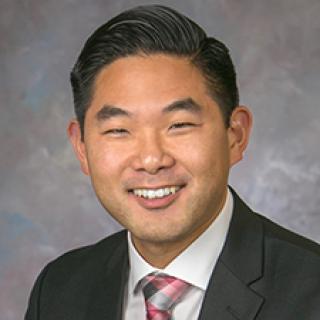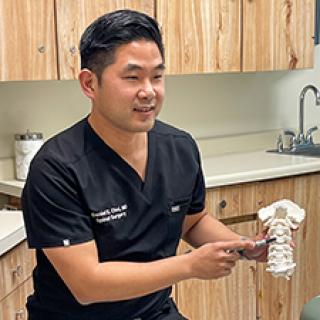As a medical student, do you ever wonder what it's like to specialize in orthopaedic spine surgery? Meet Daniel E. Choi, MD (@drdanchoi), an orthopaedic spine surgery specialist and a featured physician in the AMA's “Shadow Me” Specialty Series, which offers advice directly from physicians about life in their specialties. Check out his insights to help determine whether a career in orthopaedic spine surgery might be a good fit for you.
The AMA's Specialty Guide simplifies medical students' specialty selection process by highlighting major specialties, detailing training information and providing access to related association information. It is produced by FREIDA™, the AMA Residency & Fellowship Database®.
Learn more with the AMA about the medical specialty of orthopaedic spine surgery.
"Shadowing" Dr. Choi
Specialty: Orthopaedic spine surgery.
Practice setting: Solo practice.
Employment type: Private practice in Long Island, New York.
A typical day and week in my practice: It depends on whether I am in the operating room or the clinic. In a typical week, I spend two days in the operating room and three days in the clinic.
Clinic days tend to start a bit later, around 8:30 or 9 a.m., and I will see about 30 patients per day on average. The patient encounters vary among three types: new patients, follow-ups and preoperative or postoperative visits.
New patients are those I have never met. They are coming in with a usual complaint of neck pain, back pain or sciatica or for a second opinion regarding surgery. I perform a history and physical and start thinking about what my differential diagnosis is for the patient’s symptoms and what the next best step for the patient is. This could be an imaging study, such as an MRI, or it could be medications, physical therapy or an injection.
These patients subsequently become follow-up patients, who I reassess at the next visit to move them along the diagnosis or treatment algorithm. If they had an MRI done, I spend the follow-up visit reviewing the study with them and explaining the significance of an imaging finding.
Although I am a surgeon, I spend most of my time explaining to patients how to avoid surgery with nonoperative treatments. Most will never come close to needing surgery.
The third type of office visit is the preoperative or postoperative visit. During the preoperative visit, I spend a significant amount of time explaining the surgery in detail and potential complications, as well as answering any questions the patient or family may have about the surgery and what to expect.
During the postoperative visit, I am checking on patients who I have performed an operation on. I am assessing whether the pain they had before surgery is improved and making sure there are no signs and symptoms of a postoperative complication, such as a wound infection, blood clot in the leg or nerve damage, among others.
One of the things I keep a close eye on during my clinic day is the wait time for each of my patients. I hate to keep my patients waiting and do my best to stay on time, but I also don’t want to rush any of them and want to make sure every patient has his or her concerns addressed adequately. This can get challenging at times.
Operating room days are what every surgeon lives for and the ones I look forward to most. The first case of the day starts at 7:30 a.m., so I arrive at the hospital by 7:10 a.m. I meet my patients in the preoperative holding area, and they are understandably nervous. This is my chance to calm them down by reassuring them as best as I can and answering any remaining questions they may have about the surgery. Then we head to the operating room and the best part about my job starts: the privilege of operating.
Operating usually gets me in a flow state. Much of every surgery is routine: steps I have performed hundreds of thousands of times. Even so, I am often working millimeters away from nerves or the spinal cord, and my concentration and focus is significantly elevated for much of the surgery. Time flies by and my concentration does not break for a second to ensure that my patient gets off the table safely with his or her problem corrected.
The operating room consists of many team members, including an anesthesiologist, a scrub nurse, a circulating nurse, an implant company representative, a neuromonitoring technician and others, and it is a complex symphony of everyone working together to successfully complete the surgery. I take my role as the captain of the ship very seriously, and this means staying cool under pressure as best as I can and setting an example for the rest of the team members that everything must be done to maximize safety for the patient.
And yes, I do play music in my OR. I bring my own Bluetooth speaker and have specific Spotify playlists for the OR. Those in my OR know I have an eclectic taste in music, which ranges from ’90s rap and hip hop to Korean pop and electronic dance music.
The most challenging and rewarding aspects of orthopaedic spine surgery: I think every surgeon would agree that the most difficult part of our specialty is complications. I tell all of my patients before their surgeries, “I can do a perfect surgery and execute every step perfectly, but in the back of my mind, I know that there is still a small chance you may have a complication. It is out of my control, and this is the worst part of my job.”
Even though we know there is a certain low likelihood of complications with every surgery, surgeons still feel terrible when these complications happen to their patients. Sometimes this can lead to self-doubt and stress from wondering if you could have done anything differently, although usually there is absolutely nothing that could have been done differently. However, even with complications, there is always a way forward and this is a very critical time for the surgeon to be as supportive as possible to their patient to ensure they overcome this bump in the road to recovery.
The most rewarding aspect of my specialty is the significant direct intervention I can make in someone’s life through the use of my own hands. I have literally taken a patient who could not walk and was at risk for permanent paralysis and performed a three-to-four-hour surgery on them, and the very next day, the patient was walking without any issues. Knowing I am able to perform such powerful, life-changing interventions is very rewarding. Postoperative visits with thankful patients are the highlight of my clinic day!
Three adjectives to describe the typical orthopaedic spine surgery specialist: Decisive, tenacious and results-oriented.
Skills every physician in training should have for orthopaedic spine surgery but won’t be tested for on the board exam: First, humility, which is more of a quality than a skill set.
You need to know the limits of your skill set, experience and expertise and be humble enough to ask for help from a colleague when you are at your limits. This is especially critical in surgery, where making an error while wading in unknown territory can seriously injure a patient.
For bread-and-butter cases—the ones I have performed thousands of times—this is never an issue. But when there is a challenging case, something more rare or complex, I keep the patient's well-being in mind and ask a more experienced surgeon to scrub in with me, or I refer the patient to a surgeon who specializes in such rare or complex cases.
One question physicians in training should ask themselves before pursuing orthopaedic spine surgery: Do I love being in the operating room?
The online resource students interested in orthopaedic spine surgery should follow: The “Day in the Life” playlist by Kevin Jubbal, MD, on YouTube, which profiles various specialties. They are very well done and provide a great glimpse into the daily life one can expect within each specialty. I filmed a “Day in the Life—Orthopedic Spine Surgeon” video with him.
Quick insights I would give students who are considering orthopaedic spine surgery: Orthopaedic surgeons highly value teamwork. Residency programs are very interested in your performance in audition rotations, or subinternships, in your fourth year of medical school to assess this ability.
During your subinternship, you will be watched closely to see how you function within a team and whether you can work collaboratively. Having a high USMLE Step 1 score doesn't mean much at this point. Orthopaedic surgery is a long, five-year residency with a crazy amount of work. Team players are viewed as more adept to handle the rigors of this environment.





